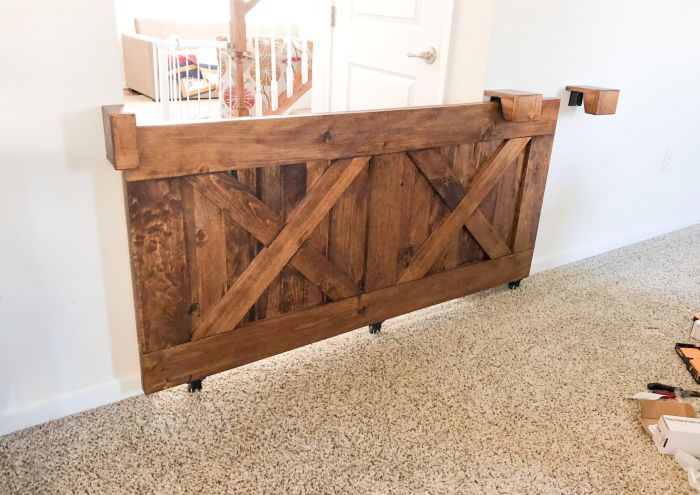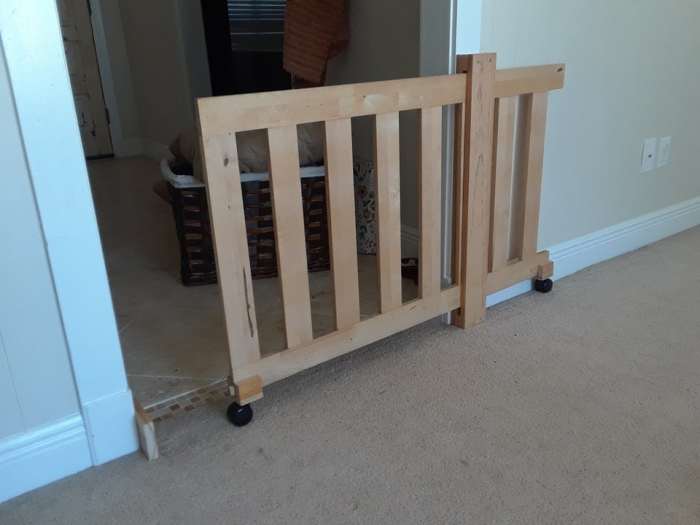DIY dog gates set the stage for a safe, stylish, and budget-friendly solution for keeping your furry friend contained. Whether you’re looking to restrict access to certain areas of your home, create a dedicated space for your dog, or simply add a touch of personalized charm, building your own dog gate can be a rewarding and fulfilling project.
Table of Contents
This guide delves into the world of DIY dog gates, exploring everything from choosing the right materials and tools to constructing a sturdy and secure gate that meets your specific needs. We’ll cover essential design considerations, step-by-step construction instructions, and helpful tips for customizing and personalizing your creation.
Planning and Design Considerations
Before you start building your DIY dog gate, it’s crucial to carefully plan and design the gate to ensure it’s both functional and safe for your dog.
Determining the Installation Area and Dimensions
The first step is to identify the specific area where you want to install the gate. This could be a doorway, hallway, or any other location where you need to restrict your dog’s access. Once you’ve chosen the area, measure its width and height accurately. These measurements will be crucial for determining the dimensions of your gate.
Choosing the Right Gate Dimensions
The height and width of the gate should be determined based on the size and breed of your dog.
- For smaller dogs, a gate height of 24 inches might be sufficient.
- For larger dogs, a height of 36 inches or more might be necessary to prevent them from jumping over it.
The width of the gate should be slightly wider than the opening to allow for easy installation and prevent the gate from getting stuck.
Gate Opening Types
There are different types of gate openings to consider, each with its own advantages and disadvantages:
- Single-door gates are the most common type. They are simple to install and operate, making them a good choice for most applications.
- Double-door gates offer more flexibility, as they can be opened from either side. This is particularly useful for areas where you need to move items through the gate frequently.
- Sliding gates are a space-saving option, especially for narrow openings. They slide along a track, eliminating the need for swinging doors.
The best type of gate opening for you will depend on your specific needs and preferences.
Step-by-Step Construction Guide: Diy Dog Gates

Now that you have your materials and design ready, it’s time to start building your dog gate. This step-by-step guide will walk you through the process, from cutting the wood to installing the hardware.
Cutting the Materials
Before you begin assembling your dog gate, you’ll need to cut the wood to the correct size. This step is crucial for ensuring that your gate fits perfectly in your doorway.
- Measure your doorway carefully, allowing for a little extra space for the gate to swing open and close easily. For example, if your doorway is 30 inches wide, you may want to cut your gate to 32 inches wide.
- Use a saw to cut the wood to the desired lengths. Be sure to wear safety goggles and gloves to protect yourself from sawdust and splinters.
- Once the wood is cut, sand the edges smooth to prevent splinters and make the gate more aesthetically pleasing.
Assembling the Frame
With the wood cut, you can now assemble the frame of your dog gate. This step involves connecting the pieces of wood together to form a sturdy and stable structure.
- Use wood glue and screws to attach the pieces of wood together. Be sure to use screws that are long enough to penetrate both pieces of wood and provide a secure connection.
- For extra strength, you can also use wood glue and screws to attach corner braces to the corners of the frame. Corner braces will help to prevent the frame from warping or bending over time.
- Make sure that the frame is square and level before moving on to the next step. Use a level to check that the frame is square, and use shims to adjust the height of the frame if necessary.
Attaching the Gate Panels
Once the frame is assembled, you can attach the gate panels. The gate panels are the vertical pieces of wood that will create the actual barrier that your dog will not be able to pass through.
- Measure the distance between the frame’s rails and cut the gate panels to size. Make sure that the panels are tall enough to prevent your dog from jumping over them.
- Attach the gate panels to the frame using wood glue and screws. Be sure to space the screws evenly to ensure that the panels are securely attached.
- Once the panels are attached, you can add any decorative elements you like, such as molding or trim.
Installing the Hardware
The final step is to install the hardware, including the hinges and the latch. This step will allow your dog gate to swing open and close easily and securely.
- Attach the hinges to the frame using screws. Make sure that the hinges are positioned so that the gate will swing open and close smoothly.
- Attach the latch to the gate using screws. Make sure that the latch is positioned so that it will securely engage with the frame.
- Once the hardware is installed, test the gate to make sure that it swings open and closes smoothly and that the latch engages securely.
Troubleshooting Tips
- If your gate is not square, you can use a level to check the frame and adjust it using shims. Be sure to secure the shims in place to prevent the gate from becoming crooked.
- If your gate is too loose, you can tighten the screws or add additional screws to the frame. You can also use wood glue to reinforce the joints.
- If your gate is too tight, you can loosen the screws or remove some of the screws. You can also sand down the edges of the gate to make it easier to swing open and close.
Alternative DIY Dog Gate Designs

Thinking outside the box when designing a DIY dog gate can lead to unique and practical solutions. Beyond basic designs, explore alternative approaches using repurposed materials, incorporating unique features, or adapting existing structures. This section explores innovative and creative DIY dog gate designs that are both functional and visually appealing.
Repurposed Materials
Repurposing materials not only saves money but also reduces waste. Consider using old doors, windows, pallets, or even metal fencing panels to create a dog gate. For instance, an old wooden door can be easily transformed into a stylish gate by adding a latch and hinges. Metal fencing panels can be joined together to form a sturdy and secure gate.
- Old Doors: Use an old wooden door as a base, adding hinges and a latch for a functional gate. Paint or stain the door to match your decor.
- Windows: Utilize old windows, especially storm windows, to create a light and airy gate. Install a secure latch and hinges. The glass panels provide visibility and allow natural light to pass through.
- Pallets: Disassemble wooden pallets and use the boards to construct a sturdy gate. Secure the boards together with screws or nails and add hinges and a latch.
- Metal Fencing Panels: Combine multiple metal fencing panels to create a strong and durable gate. Secure the panels together using metal brackets or bolts.
Unique Features
Incorporating unique features can add functionality and visual appeal to your DIY dog gate. Think about features like built-in storage, adjustable heights, or decorative elements.
- Built-in Storage: Add shelves or compartments to the gate for storing dog toys, leashes, or other essentials. This creates a functional and organized space.
- Adjustable Height: Design the gate with adjustable height settings to accommodate dogs of different sizes. This ensures that the gate remains effective as your dog grows.
- Decorative Elements: Enhance the gate’s visual appeal with decorative elements like stencils, paint, or decorative hardware. This allows you to personalize the gate to match your home’s style.
Adapting Existing Structures
Instead of building a completely new gate, consider adapting an existing structure to create a dog gate. This can save time and effort.
- Existing Doorways: Install a gate within an existing doorway using a simple frame and a latch. This is a quick and easy solution for blocking off specific areas.
- Existing Fences: Add a gate section to an existing fence by using fence panels or by building a custom gate to match the fence’s style.
- Stairwells: Create a gate at the top or bottom of a stairwell to prevent your dog from accessing the stairs. This ensures safety and prevents accidents.
Examples of Innovative DIY Dog Gate Designs, Diy dog gates
Here are some examples of innovative and creative DIY dog gate designs:
- A repurposed window gate with a built-in storage shelf. This design provides both visibility and functionality, offering a space to store dog-related items.
- A pallet gate with an adjustable height feature. This allows the gate to adapt to the size of different dogs.
- A metal fencing panel gate with a decorative trellis. This design adds a touch of elegance to the gate while providing a sturdy barrier.
With a little creativity, effort, and the right tools, you can build a DIY dog gate that is both functional and aesthetically pleasing. Whether you opt for a simple, classic design or embrace a more elaborate and personalized style, your DIY dog gate will not only enhance your home’s functionality but also showcase your love for your furry companion.
DIY dog gates are a great way to keep your furry friend safe and contained. They can be as simple or as elaborate as you like, depending on your budget and skill level. If you’re looking for inspiration, you can find many helpful resources online, like this article about flibanserin , which discusses the benefits of this medication. Whether you’re a seasoned DIYer or a beginner, creating a dog gate can be a rewarding project, allowing you to personalize your home and ensure your pet’s safety.

